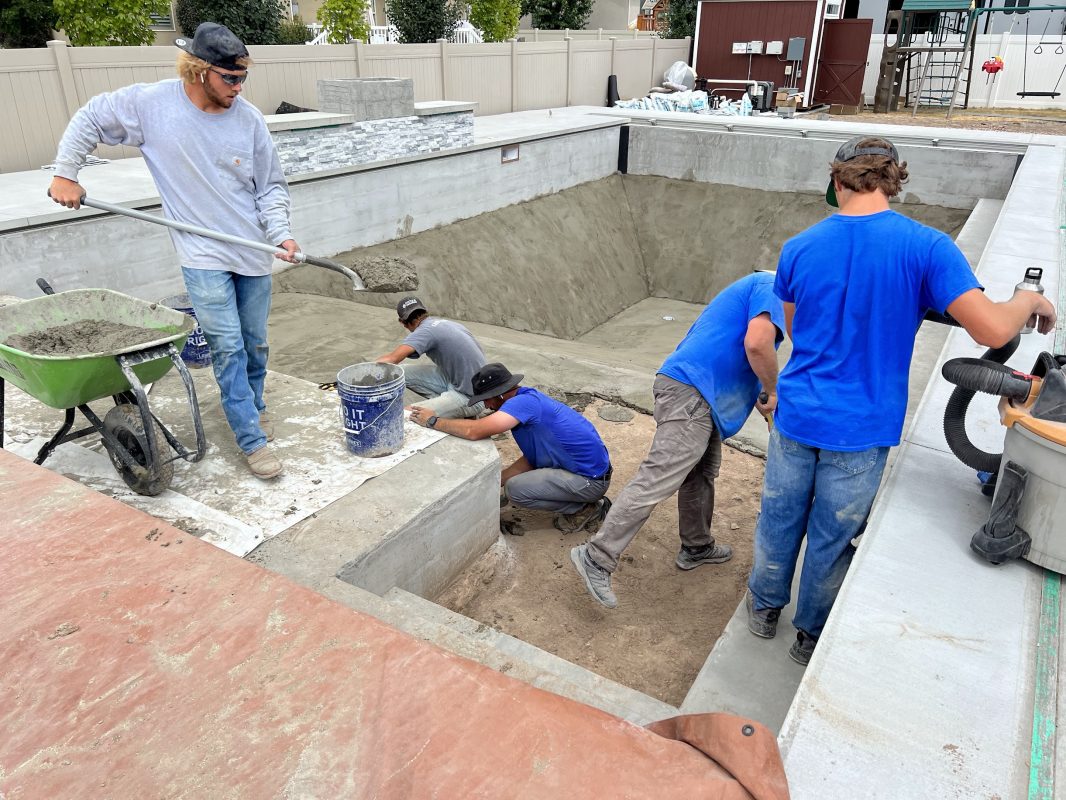Frequently Asked Questions
Have questions?
Check this section and if you don’t see your answer

Pools and Projects is a vinyl liner custom pool contractor. We love the smooth surface and easy upkeep. Our own pool is a vinyl liner pool that our five boys, one daughter, and their families and their hundreds of friends have enjoyed for years. I also can’t forget the 6 dogs between us and our adult children. The pool has become a gathering spot for our families.
As a vinyl liner custom pool builder and pool owner, we are asked what should people look for in a pool contractor builder.
Contact Us to Learn How We can Help You

This is where you will find some differences between pool construction. Most vinyl liner pools are one of four types of side walls: Cinderblock, ICF, Metal or Polymer
Cinderblock – The builder will lay 8 inch concrete blocks on top of the earth to build a 32 inch wall out of cinderblock. The engineering requires #5 (5/8 inch) rebar all the way around the bottom and top courses. #3 (3/8 inch) rebar is inserted vertically every 2 feet in all walls. This rebar is bent into the pool deck for a minimum of 3 feet. The top of the pool deck has two #4 (1/2 inch) rebar tied to the bent vertical rebar all the way around the pool except for where the automatic pool cover enters the vault. Below the cinderblock wall, the earth is shaped on an angle to support the bottom of the wall to mesh with the rest of the dirt and is covered in poolkrete. The walls are covered with mortar to create a smooth surface for the liner to go against.
While some may worry about cinderblock pool walls being prone to cracking due to their porous nature, the real issue lies in improper installation. When engineered correctly, covered with mortar, reinforced with rebar, and filled with concrete, cinderblock walls become incredibly durable and structurally sound. This method ensures a solid, long-lasting pool structure that stands up to water pressure and soil movement, making it a superior choice when installed by professionals.
Some builders will set the corners with the blocks touching in the pool side corner but open on the back side. Some lay a 6 inch wide block at a 45 degree angle with the front corners touching and the back side open. The builder will set a form on the back side and fill with concrete. This does work but is a natural seam from top to bottom for the concrete to crack and move. Overlapping the two walls in the corner, as done by our professionals, provides a much stronger wall without a natural seam.
Insulated Concrete Forms (ICF) – These pools are built similarly to a cinderblock wall. However, it is imperative a 3 inch cap be poured on top of the ICF for the automatic pool cover encapsulation to be installed. Failure to do this may result in the cover encapsulation and track being pulled through the ICF wall leaving a significant repair. The wall is usually covered with a 1/16 inch PVC paneling and tacked onto the ICF.
The primary concern with using ICF (Insulated Concrete Forms) walls in pools is their potential inability to withstand the significant hydrostatic pressure from water, leading to structural instability and potential cracking, especially if not properly designed and reinforced; additionally, improper waterproofing can lead to moisture issues within the wall structure, requiring careful attention to details during construction.
We have had to repair pools done with inferior construction and without the cap, causing the cover to collapse into the pool.
Metal – These pools are manufactured to the size and shape you want. The metal is usually 14 gauge (5/64 inch) steel staked into the ground with supports installed every 4-8 feet. These triangular designed supports or braces go from top of the metal wall to the bottom of the wall. They are a couple of inches wide and support back about 12-16 inches. Two #4 (1/2 inch) rebar are installed all the way around the bottom of the pool and covered with 6-8 inches of concrete.
The primary problem with metal walls in swimming pools is corrosion, most commonly manifesting as rust, which can significantly weaken the pool structure over time due to exposure to water, chemicals like chlorine, and air, eventually leading to leaks and potential structural failure if not properly maintained; this issue is particularly prevalent with steel walls in pools.
Polymer – Similar to metal walls, except the wall is made out of plastic polymer and not metal. Because it is plastic it is usually thicker at 1/8 inch.
Potential issues with polymer pool walls include: cracking due to brittleness, difficulty with expansion and contraction in cold climates, potential for shifting or bowing, susceptibility to damage during installation or backfilling, and sometimes higher cost compared to steel wall pools, especially if not properly installed or backfilled with the right materials; requiring careful attention to pressure equalization during pool filling to prevent wall damage.
We recommend 2″+ plumbing. Some builders will use 1 ½” plumbing, which has been the industry standard for years, but now there are many features that require more. There really isn’t a reason to go less than 2” plumbing except to save money. Yes it works on a very basic pool and usually isn’t a problem, but if you want water features or want to upgrade in the future, you will have to redo your whole plumbing to increase the water flow. A 1 ½” PVC pipe will flow 35 GPM while a 2” PVC pipe will flow 63 GPM. This is a much higher flow for little increase in cost.
Also, make sure when getting bids to ensure that the builders have a policy that if you have have more than one skimmer the builder runs plumbing for each skimmer back to the equipment pad and comes out of the ground separately. This will allow you to control the flow from each skimmer and provide increased capacity if you ever add features needing water supply or have a suction automatic pool cleaner.
A well-functioning pool relies on essential equipment, including pumps, filters, heaters, and chlorinators. Here’s a breakdown of each component and how they work together to keep your pool in top shape.
Pumps circulate water through your pool’s filtration and sanitation systems. You can choose between single-speed and variable-speed pumps:
• Single-speed pumps run at full power whenever they’re on.
• Variable-speed pumps allow you to adjust the speed based on your needs. Want more power for vacuuming? Increase the speed. Prefer quieter operation and energy efficiency? Lower the speed.
Why choose a variable-speed pump?
Variable-speed pumps are more energy-efficient, saving you money by adjusting to the pool’s needs. They also offer quieter operation, better filtration, and greater control over water circulation. You can run the pump at a lower speed for daily maintenance and only increase power when necessary.
💡 Bonus Tip: If you add automation, you can control your pump directly from your phone! Our specialists will set it up, so you never have to guess the right speed.
Filters keep your pool water clean by removing dirt and debris. There are three main types:
• Sand Filters – Requires weekly backwashing to flush out trapped debris.
• Diatomaceous Earth (DE) Filters – Provides finer filtration but also needs weekly backwashing.
• Cartridge Filters – No backwashing needed, but requires deep cleaning 1-2 times per season.
💡 Maintenance Tip: Filters should be replaced every 2-3 years. Choosing the right size is crucial—if your filter’s flow rate is too low, it may not support features like waterfalls, slides, or multiple returns. Your pool builder will ensure proper sizing for your needs.
Pool heaters come in different sizes, typically measured in BTUs (British Thermal Units):
•A 250,000 – 260,000 BTU heater is standard.
•Upgrading to a 400,000 BTU heater (for an additional $600-$900) will heat your pool faster and more efficiently.
💡 Pro Tip: A gas heater requires an appropriately sized gas line. Even if you install a smaller heater now, we recommend running a line sufficient for 400,000 BTUs in case you upgrade later.
Keeping your pool sanitized is essential, and there are two main methods:
• Tablet Chlorinators – Requires manual monitoring and adding chlorine tablets.
• Saltwater Chlorinators (Salt Cells) – Convert sodium chloride (NaCl) into chlorine, maintaining water balance with minimal effort.
💡 Why choose a saltwater system? Salt cells make pool maintenance easier and more consistent, reducing the need for manual chlorine adjustments.
Pool equipment can be controlled in three ways:
• Monitor water chemistry from your phone.
• Automate chemical adjustments (if equipped with a chemical dosing system).
• Customize multiple pool functions for ultimate convenience.
💡 Why upgrade to automation? It simplifies pool management, giving you full control at your fingertips—anytime, anywhere.
When planning your dream backyard pool, the patio is just as important as the pool itself. The right amount of deck space ensures your pool area is functional, comfortable, and visually appealing. But how much patio do you really need? Let’s break it down.
At the very least, you’ll need enough deck space to walk around the pool safely. For engineering purposes, you will need at least 3 feet of clearance around the pool’s edge. We provide 4’x4’x4’x10′. This ensures:
✅ Easy movement around the pool
✅ Safe entry and exit
✅ Space for maintenance tasks
Love to relax by the pool? Consider how much space you need for loungers, chairs, and tables. Here’s a quick guide:
• Single lounge chair – Allow 6-8 feet of depth to recline comfortably.
• Multiple loungers – Need at least 8-10 feet of patio space.
• Dining area (table & chairs) – Requires 10-12 feet for easy movement.
If you plan to entertain guests, a larger patio (12+ feet) gives plenty of space for gatherings without feeling cramped.
Thinking about adding a firepit, outdoor kitchen, pergola, or hot tub? Each of these features requires extra space:
🔥 Firepit with seating – Allow 6-8 feet around the fire feature.
🍔 Outdoor kitchen – Needs at least 10 feet for proper cooking and prep space.
🌿 Pergolas/cabanas – Usually require 10-15 feet depending on size.
If you have kids or plan to entertain often, opt for a larger patio. A spacious deck:
👶 Accommodates pool toys & play areas
🏊♂️ Provides a comfortable area for parents to supervise
🎉 Offers plenty of room for gatherings and pool parties
Your available space will also influence patio size. Some design considerations:
📐 Rectangular pools work well with symmetrical or free patio designs.
🏡 Small yards may require creative solutions like multi-level decking or built-in seating.
While every backyard is different, here are some general recommendations:
|
Pool Type |
Suggested Patio Space |
|---|---|
|
Small Pools (10×20 ft) |
6-8 ft of patio around the pool |
|
Medium Pools (15×30 ft) |
8-12 ft of patio space |
|
Large Pools (20×40 ft) |
12-16 ft of patio space |
For a luxury outdoor living space, aim for at least 1,000+ square feet of total patio area.
Your pool patio should match your lifestyle. If you just need a simple walkway, 4 feet might be enough. But if you love to entertain, relax, and maximize your backyard’s potential, aim for at least 8-12 feet of patio space.
Still unsure how much patio you need? Our team at Pools and Projects LLC can help design the perfect layout for your space and budget. Contact us today to get started!